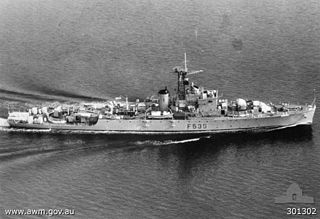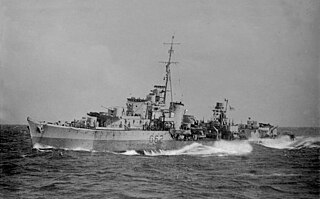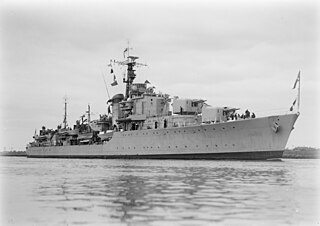Related Research Articles

Five ships of the Royal Australian Navy have been named HMAS Sydney, after Sydney, the capital city of New South Wales.
Two ships of the Royal Australian Navy have borne the name HMAS Arunta, a name derived from the Arrernte Aboriginals of central Australia.
HMT Ballarat, built for P&O in 1911 to expand its Blue Anchor Line subsidiary. Requisitioned as a troopship in the First World War. On 25 April 1917 a German submarine torpedoed her in the English Channel. All her passengers and crew were rescued and she was taken in tow, but she sank the next day.

HMAS Newcastle, named for the city of Newcastle, New South Wales, the largest provincial city in Australia, was an Adelaide-class guided-missile frigate. The last ship of the class to be constructed, Newcastle entered service with the Royal Australian Navy in 1993. During her career, the frigate has operated as part of the INTERFET peacekeeping taskforce, served in the Persian Gulf, and responded to the 2006 Fijian coup d'état. The frigate was decommissioned on 30 June 2019 and transferred to the Chilean Navy on 15 April 2020 and renamed as Capitán Prat.
Four ships of the Royal Australian Navy been named HMAS Parramatta, for the Parramatta River. The name comes from the Barramattagal people.
Three ships of the Royal Australian Navy (RAN) have been named HMAS Perth after Perth, the capital city of Western Australia.

HMAS Quiberon (G81/D20/D281/F03) was a Q-class destroyer of the Royal Australian Navy (RAN). Although built for the Royal Navy and remaining British property until 1950, Quiberon was one of two Q-class destroyers commissioned into the RAN during World War II. She was passed into full RAN ownership in 1950, and converted into an anti-submarine frigate.

HMAS Quickmatch (G92/D21/D292/F04) was a Q-class destroyer operated by the Royal Australian Navy (RAN). Although commissioned into the RAN in 1942, the ship was initially the property of the Royal Navy. Quickmatch served with both the British Eastern Fleet and British Pacific Fleet during World War II. In the 1950s, the destroyer was converted into an anti-submarine frigate. In 1957, Quickmatch operated in support of Malaya during the Malayan Emergency. The ship remained in service until 1963, and after use as an accommodation ship, was sold for scrap in 1972.

HMAS Shoalhaven (K535/M535/F535), named for the Shoalhaven River in New South Wales, was a modified River-class frigate of the Royal Australian Navy. She was laid down by Walkers at Maryborough on 18 December 1943, launched on 14 December 1944 by Senator Dorothy Tangney and commissioned at Urangan Pier in Hervey Bay in Queensland on 2 May 1946. Her first commander was Commander Rodney Rhoades.
Three ships of the Royal Australian Navy (RAN) have been named HMAS Stuart:
Two ships of the Royal Australian Navy (RAN) have been named HMAS Vampire.
Two ships of the Royal Australian Navy (RAN) have been named HMAS Vendetta.
Two ships of the Royal Australian Navy have been named HMAS Warramunga, after the Warumungu Aborigines.
There have been one ship and one shore establishment in the Royal Australian Navy (RAN) named HMAS Waterhen. The first ship originally served under the name HMS Waterhen with the Royal Navy (RN). A British ship and an Australian ship of the name were ordered but later cancelled.

HMAS Queenborough (G70/D270/F02/57) was a Q-class destroyer that served in the Royal Navy (RN) and Royal Australian Navy (RAN).

HMS Quality (G62/D18) was a Q-class destroyer built for the Royal Navy. Entering service in 1942, the destroyer served in several theatres of World War II. Following the war's conclusion, the ship was transferred to the Royal Australian Navy (RAN), commissioning as HMAS Quality (G62/D262) in late 1945. Unlike her sister ships, which were refitted as anti-submarine frigates, Quality was not modified, decommissioned after only 59 days of service, and was sold for scrap in 1958.
Two ships of the Royal Australian Navy have been named HMAS Toowoomba, after the city of Toowoomba, Queensland.

HMAS Anzac is the lead ship of the Anzac-class frigates in use with the Royal Australian Navy (RAN) and the Royal New Zealand Navy (RNZN). Entering Australian service in 1996, the frigate operated as part of the INTERFET peacekeeping taskforce in 1999. In 2003, she was involved in the Battle of Al Faw, and became the first RAN ship to fire in anger since the Vietnam War. The ship is operational as of 2021.

HMAS Anzac (D59) was a Battle-class destroyer of the Royal Australian Navy (RAN). Named after the Australian and New Zealand Army Corps, the destroyer was commissioned in 1951. The ship served on two tours of duty during the Korean War, and attempts to distinguish herself from British ships led to the practice of red kangaroo symbols on Australian warships. During 1956, Anzac served during the Malayan Emergency. In 1960, a malfunction in the destroyer's gun direction equipment caused Anzac to fire directly on sister ship HMAS Tobruk during a gunnery exercise, with Tobruk left unrepairable. In 1961, the destroyer was reclassified as a training vessel. Anzac remained in service until 1974, and was sold for breaking a year later.

HMAS Tobruk (D37) was a Battle-class destroyer of the Royal Australian Navy (RAN). Built at the Cockatoo Island Dockyard, the destroyer was completed in 1950. Tobruk was deployed to the Korean War twice, and served with the Far East Strategic Reserve on three occasions during the late 1950s. In 1960, she was damaged beyond economical repair by sister ship HMAS Anzac during a gunnery exercise, which led to the destroyer's decommissioning that year, and sale for scrap in 1971.
References
- ↑ "First Lady of the Fleet Trophy" . Retrieved 9 October 2023.
- ↑ "Navy Marks 109th Birthday With Historic Changes To Battle Honours". Royal Australian Navy. 1 March 2010. Archived from the original on 13 June 2011. Retrieved 23 December 2012.
- ↑ "Royal Australian Navy Ship/Unit Battle Honours" (PDF). Royal Australian Navy. 1 March 2010. Archived from the original (PDF) on 14 June 2011. Retrieved 23 December 2012.